International Trade Analysis: Production Possibilities and Trade
VerifiedAdded on 2023/06/05
|17
|3319
|198
Homework Assignment
AI Summary
This assignment delves into the core concepts of international trade, starting with an analysis of absolute and comparative advantage between two countries in the production of butter and cloth. It then explores how countries can benefit from trade by specializing in goods where they have a comparative advantage, leading to increased consumption possibilities. The assignment uses production possibility frontiers to illustrate the gains from trade and examines the impact of trade on relative prices and labor hours. Furthermore, it provides a detailed explanation of how countries determine their specialization and the resulting benefits in terms of consumption possibilities before and after trade, considering scenarios with varying labor hours and production costs. The document also covers the concept of opportunity cost and how it determines comparative advantage, and it examines the effects of trade on consumption patterns and welfare in both countries. The assignment concludes with a discussion on the benefits of specialization and trade based on comparative advantage.
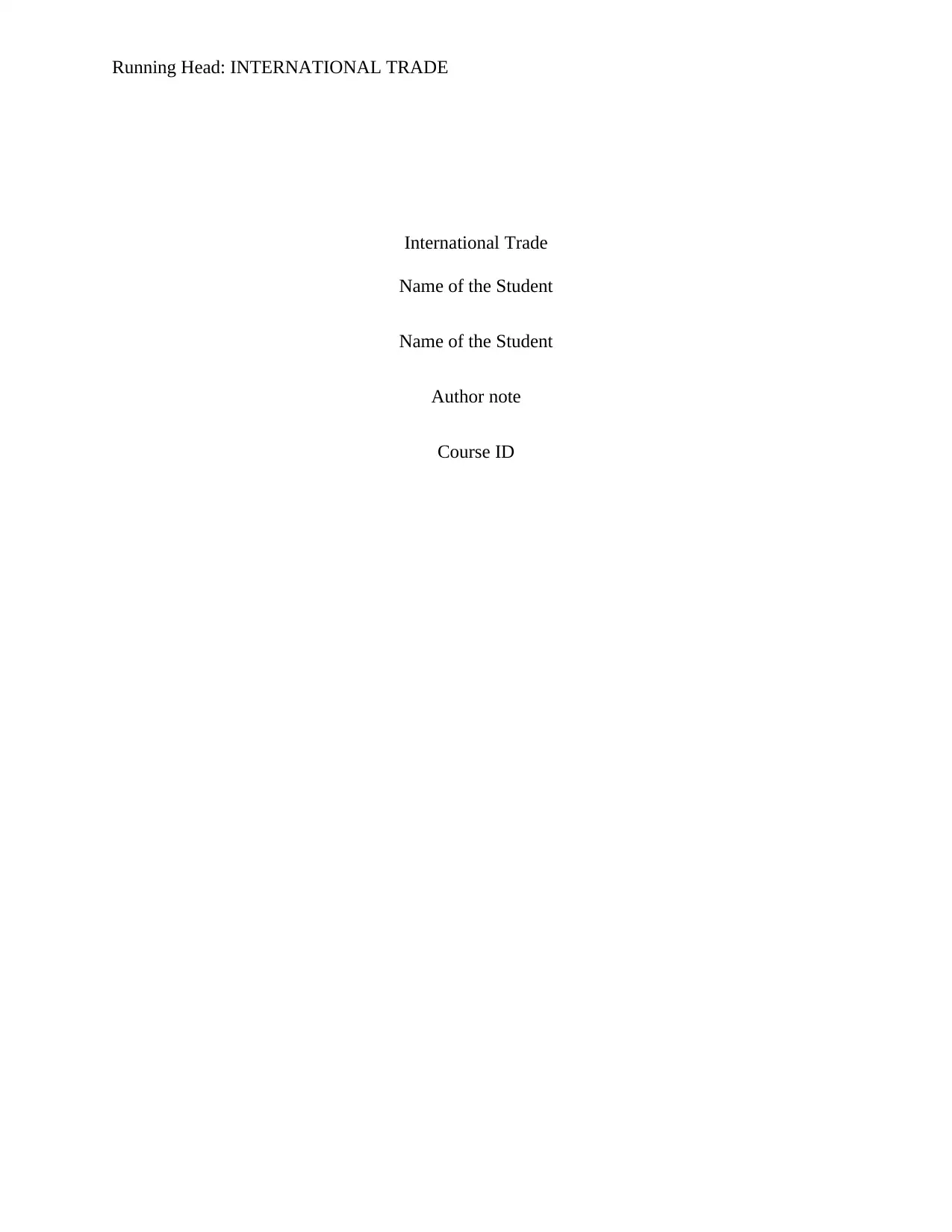
Running Head: INTERNATIONAL TRADE
International Trade
Name of the Student
Name of the Student
Author note
Course ID
International Trade
Name of the Student
Name of the Student
Author note
Course ID
Paraphrase This Document
Need a fresh take? Get an instant paraphrase of this document with our AI Paraphraser
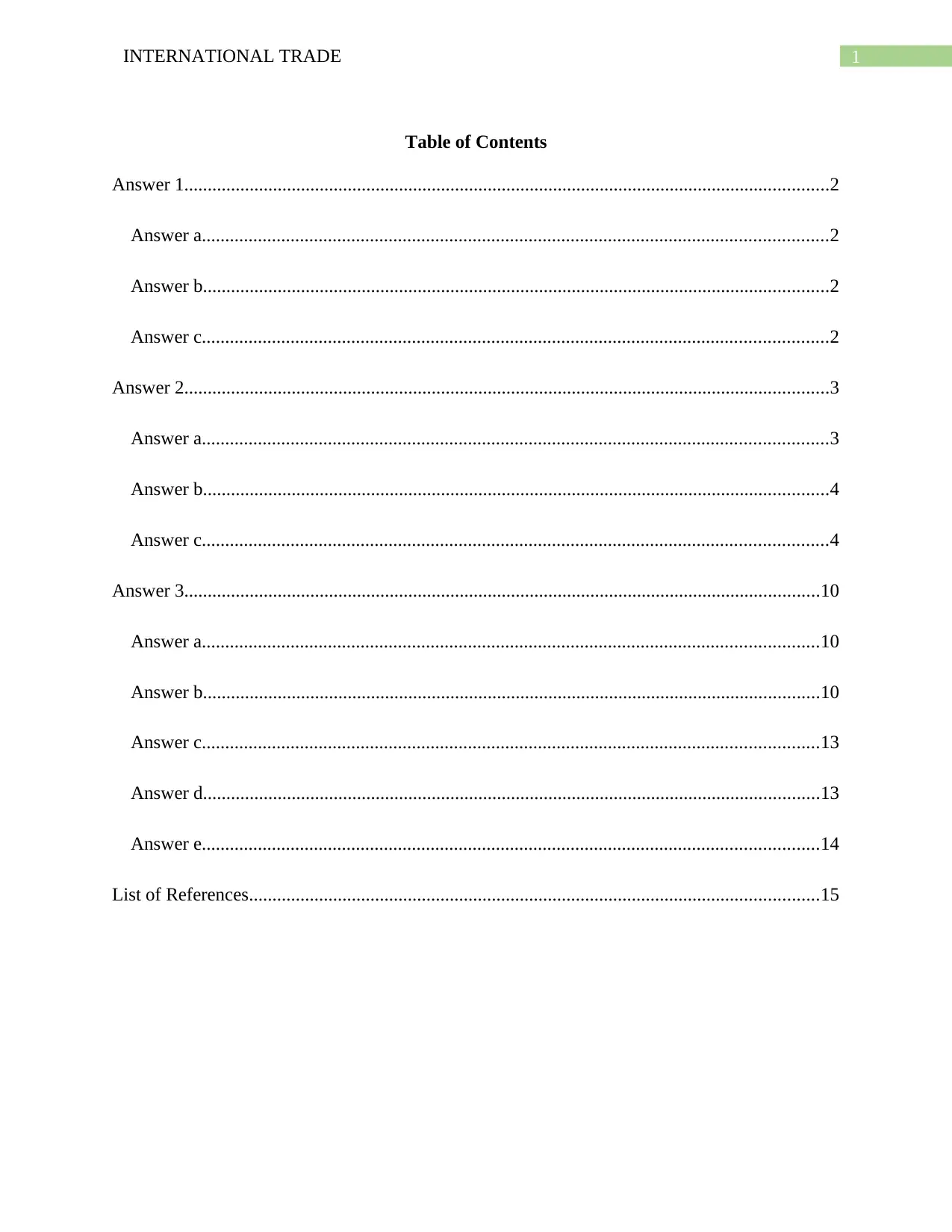
1INTERNATIONAL TRADE
Table of Contents
Answer 1..........................................................................................................................................2
Answer a......................................................................................................................................2
Answer b......................................................................................................................................2
Answer c......................................................................................................................................2
Answer 2..........................................................................................................................................3
Answer a......................................................................................................................................3
Answer b......................................................................................................................................4
Answer c......................................................................................................................................4
Answer 3........................................................................................................................................10
Answer a....................................................................................................................................10
Answer b....................................................................................................................................10
Answer c....................................................................................................................................13
Answer d....................................................................................................................................13
Answer e....................................................................................................................................14
List of References..........................................................................................................................15
Table of Contents
Answer 1..........................................................................................................................................2
Answer a......................................................................................................................................2
Answer b......................................................................................................................................2
Answer c......................................................................................................................................2
Answer 2..........................................................................................................................................3
Answer a......................................................................................................................................3
Answer b......................................................................................................................................4
Answer c......................................................................................................................................4
Answer 3........................................................................................................................................10
Answer a....................................................................................................................................10
Answer b....................................................................................................................................10
Answer c....................................................................................................................................13
Answer d....................................................................................................................................13
Answer e....................................................................................................................................14
List of References..........................................................................................................................15
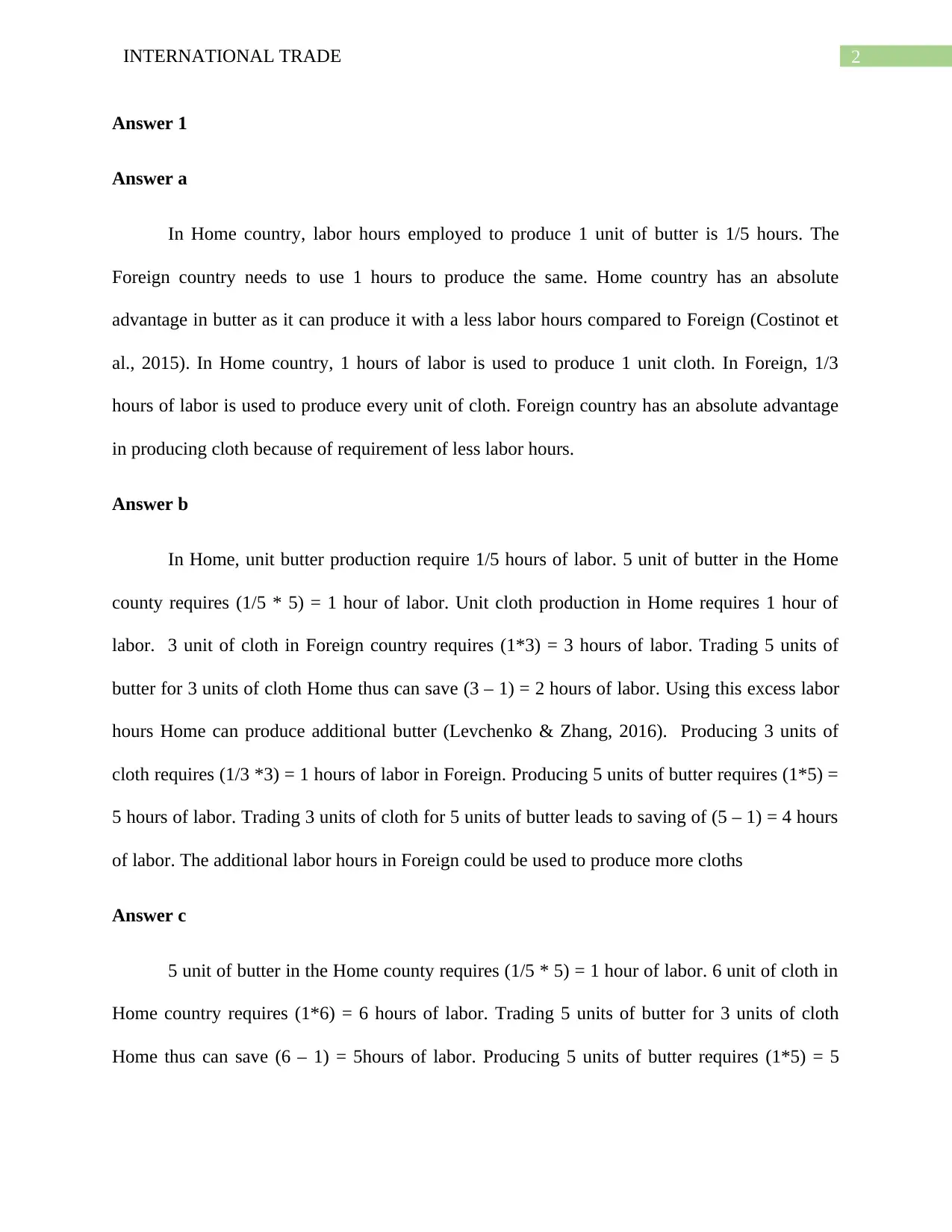
2INTERNATIONAL TRADE
Answer 1
Answer a
In Home country, labor hours employed to produce 1 unit of butter is 1/5 hours. The
Foreign country needs to use 1 hours to produce the same. Home country has an absolute
advantage in butter as it can produce it with a less labor hours compared to Foreign (Costinot et
al., 2015). In Home country, 1 hours of labor is used to produce 1 unit cloth. In Foreign, 1/3
hours of labor is used to produce every unit of cloth. Foreign country has an absolute advantage
in producing cloth because of requirement of less labor hours.
Answer b
In Home, unit butter production require 1/5 hours of labor. 5 unit of butter in the Home
county requires (1/5 * 5) = 1 hour of labor. Unit cloth production in Home requires 1 hour of
labor. 3 unit of cloth in Foreign country requires (1*3) = 3 hours of labor. Trading 5 units of
butter for 3 units of cloth Home thus can save (3 – 1) = 2 hours of labor. Using this excess labor
hours Home can produce additional butter (Levchenko & Zhang, 2016). Producing 3 units of
cloth requires (1/3 *3) = 1 hours of labor in Foreign. Producing 5 units of butter requires (1*5) =
5 hours of labor. Trading 3 units of cloth for 5 units of butter leads to saving of (5 – 1) = 4 hours
of labor. The additional labor hours in Foreign could be used to produce more cloths
Answer c
5 unit of butter in the Home county requires (1/5 * 5) = 1 hour of labor. 6 unit of cloth in
Home country requires (1*6) = 6 hours of labor. Trading 5 units of butter for 3 units of cloth
Home thus can save (6 – 1) = 5hours of labor. Producing 5 units of butter requires (1*5) = 5
Answer 1
Answer a
In Home country, labor hours employed to produce 1 unit of butter is 1/5 hours. The
Foreign country needs to use 1 hours to produce the same. Home country has an absolute
advantage in butter as it can produce it with a less labor hours compared to Foreign (Costinot et
al., 2015). In Home country, 1 hours of labor is used to produce 1 unit cloth. In Foreign, 1/3
hours of labor is used to produce every unit of cloth. Foreign country has an absolute advantage
in producing cloth because of requirement of less labor hours.
Answer b
In Home, unit butter production require 1/5 hours of labor. 5 unit of butter in the Home
county requires (1/5 * 5) = 1 hour of labor. Unit cloth production in Home requires 1 hour of
labor. 3 unit of cloth in Foreign country requires (1*3) = 3 hours of labor. Trading 5 units of
butter for 3 units of cloth Home thus can save (3 – 1) = 2 hours of labor. Using this excess labor
hours Home can produce additional butter (Levchenko & Zhang, 2016). Producing 3 units of
cloth requires (1/3 *3) = 1 hours of labor in Foreign. Producing 5 units of butter requires (1*5) =
5 hours of labor. Trading 3 units of cloth for 5 units of butter leads to saving of (5 – 1) = 4 hours
of labor. The additional labor hours in Foreign could be used to produce more cloths
Answer c
5 unit of butter in the Home county requires (1/5 * 5) = 1 hour of labor. 6 unit of cloth in
Home country requires (1*6) = 6 hours of labor. Trading 5 units of butter for 3 units of cloth
Home thus can save (6 – 1) = 5hours of labor. Producing 5 units of butter requires (1*5) = 5
⊘ This is a preview!⊘
Do you want full access?
Subscribe today to unlock all pages.

Trusted by 1+ million students worldwide

3INTERNATIONAL TRADE
hours of labor. Producing 6 units of cloth requires (1/3 *6) = 2 hours of labor in Foreign. Trading
3 units of cloth for 5 units of butter leads to saving of (5 – 2) = 3 hours of labor.
Answer 2
Answer a
Figure 1: Production Possibilities (Home)
hours of labor. Producing 6 units of cloth requires (1/3 *6) = 2 hours of labor in Foreign. Trading
3 units of cloth for 5 units of butter leads to saving of (5 – 2) = 3 hours of labor.
Answer 2
Answer a
Figure 1: Production Possibilities (Home)
Paraphrase This Document
Need a fresh take? Get an instant paraphrase of this document with our AI Paraphraser
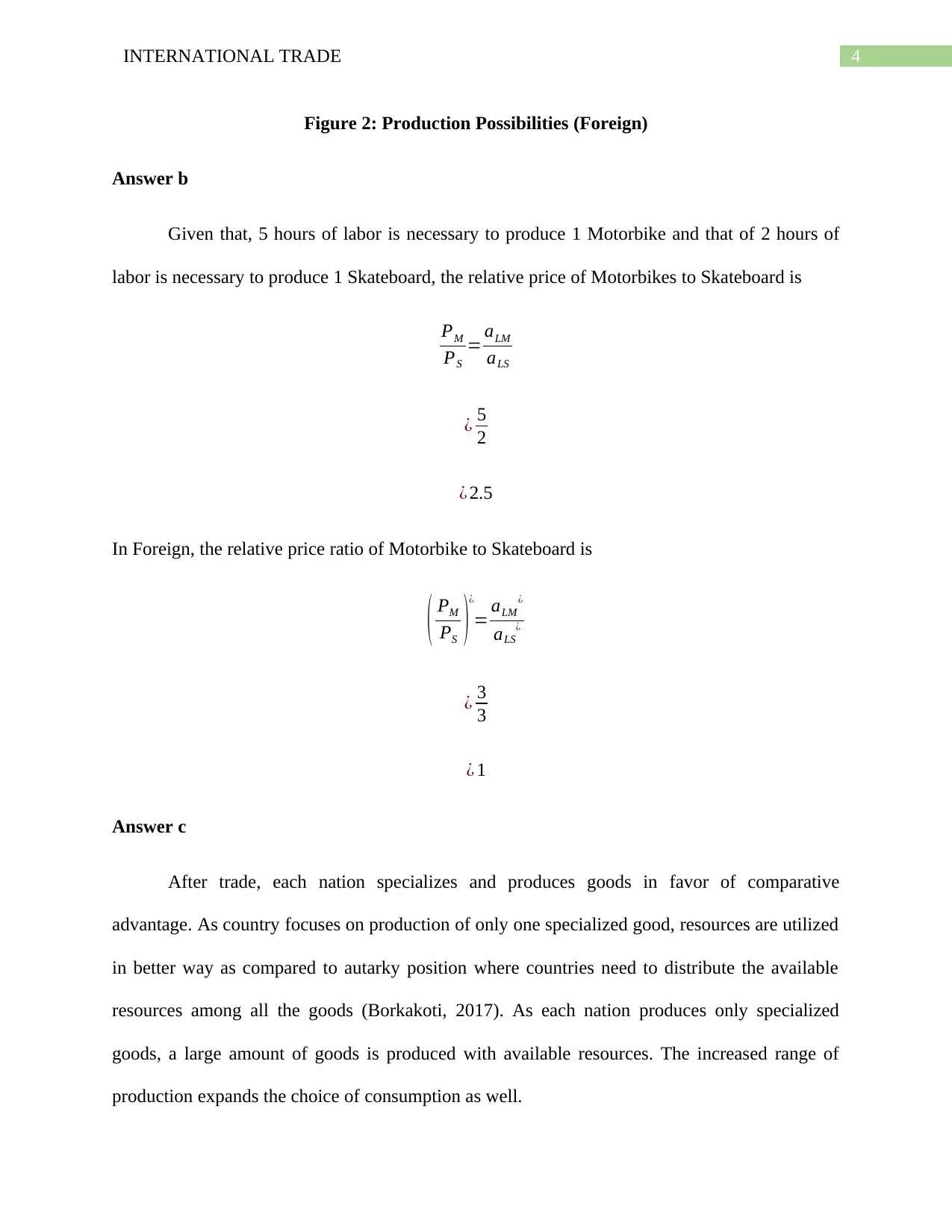
4INTERNATIONAL TRADE
Figure 2: Production Possibilities (Foreign)
Answer b
Given that, 5 hours of labor is necessary to produce 1 Motorbike and that of 2 hours of
labor is necessary to produce 1 Skateboard, the relative price of Motorbikes to Skateboard is
PM
PS
= aLM
aLS
¿ 5
2
¿ 2.5
In Foreign, the relative price ratio of Motorbike to Skateboard is
( PM
PS )¿
= aLM
¿
aLS
¿
¿ 3
3
¿ 1
Answer c
After trade, each nation specializes and produces goods in favor of comparative
advantage. As country focuses on production of only one specialized good, resources are utilized
in better way as compared to autarky position where countries need to distribute the available
resources among all the goods (Borkakoti, 2017). As each nation produces only specialized
goods, a large amount of goods is produced with available resources. The increased range of
production expands the choice of consumption as well.
Figure 2: Production Possibilities (Foreign)
Answer b
Given that, 5 hours of labor is necessary to produce 1 Motorbike and that of 2 hours of
labor is necessary to produce 1 Skateboard, the relative price of Motorbikes to Skateboard is
PM
PS
= aLM
aLS
¿ 5
2
¿ 2.5
In Foreign, the relative price ratio of Motorbike to Skateboard is
( PM
PS )¿
= aLM
¿
aLS
¿
¿ 3
3
¿ 1
Answer c
After trade, each nation specializes and produces goods in favor of comparative
advantage. As country focuses on production of only one specialized good, resources are utilized
in better way as compared to autarky position where countries need to distribute the available
resources among all the goods (Borkakoti, 2017). As each nation produces only specialized
goods, a large amount of goods is produced with available resources. The increased range of
production expands the choice of consumption as well.
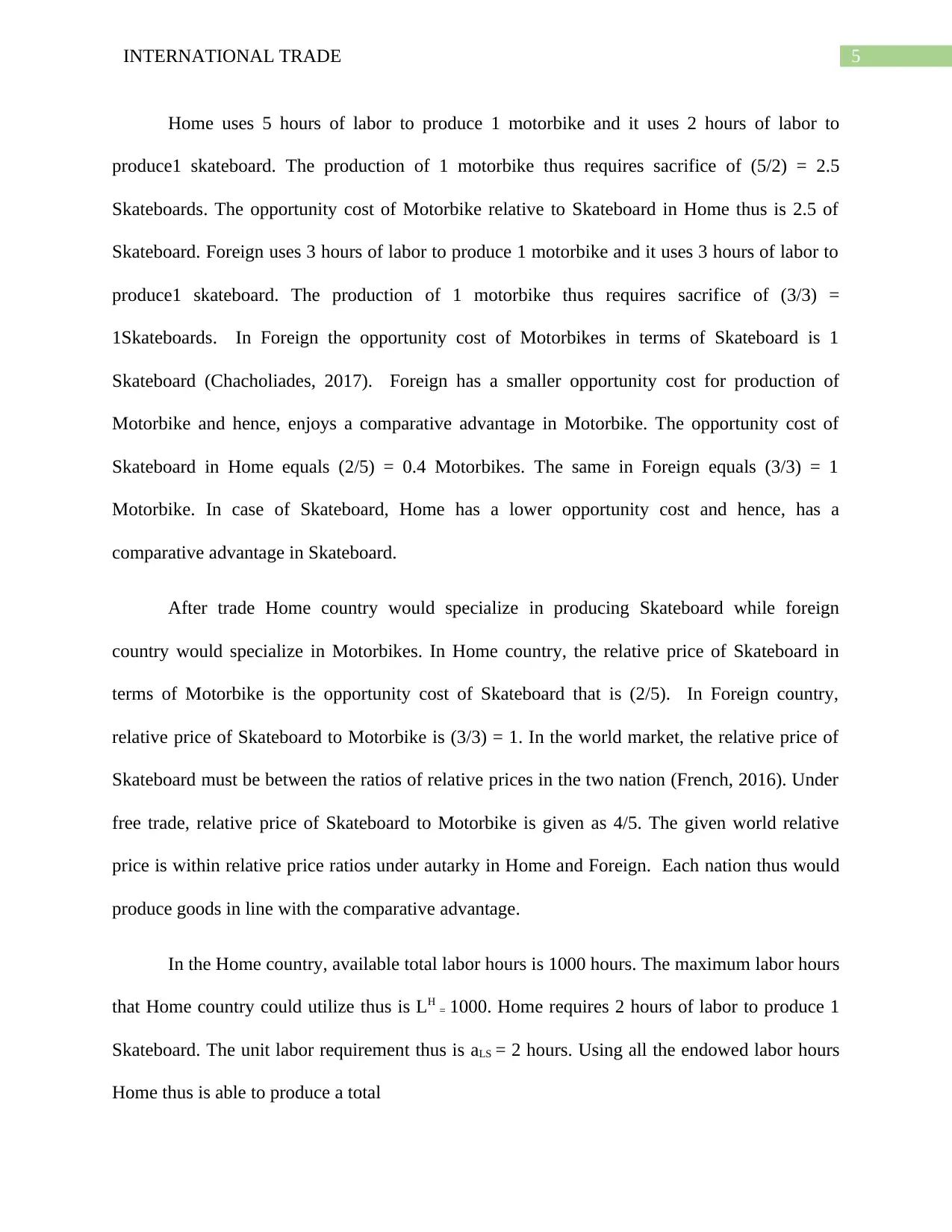
5INTERNATIONAL TRADE
Home uses 5 hours of labor to produce 1 motorbike and it uses 2 hours of labor to
produce1 skateboard. The production of 1 motorbike thus requires sacrifice of (5/2) = 2.5
Skateboards. The opportunity cost of Motorbike relative to Skateboard in Home thus is 2.5 of
Skateboard. Foreign uses 3 hours of labor to produce 1 motorbike and it uses 3 hours of labor to
produce1 skateboard. The production of 1 motorbike thus requires sacrifice of (3/3) =
1Skateboards. In Foreign the opportunity cost of Motorbikes in terms of Skateboard is 1
Skateboard (Chacholiades, 2017). Foreign has a smaller opportunity cost for production of
Motorbike and hence, enjoys a comparative advantage in Motorbike. The opportunity cost of
Skateboard in Home equals (2/5) = 0.4 Motorbikes. The same in Foreign equals (3/3) = 1
Motorbike. In case of Skateboard, Home has a lower opportunity cost and hence, has a
comparative advantage in Skateboard.
After trade Home country would specialize in producing Skateboard while foreign
country would specialize in Motorbikes. In Home country, the relative price of Skateboard in
terms of Motorbike is the opportunity cost of Skateboard that is (2/5). In Foreign country,
relative price of Skateboard to Motorbike is (3/3) = 1. In the world market, the relative price of
Skateboard must be between the ratios of relative prices in the two nation (French, 2016). Under
free trade, relative price of Skateboard to Motorbike is given as 4/5. The given world relative
price is within relative price ratios under autarky in Home and Foreign. Each nation thus would
produce goods in line with the comparative advantage.
In the Home country, available total labor hours is 1000 hours. The maximum labor hours
that Home country could utilize thus is LH = 1000. Home requires 2 hours of labor to produce 1
Skateboard. The unit labor requirement thus is aLS = 2 hours. Using all the endowed labor hours
Home thus is able to produce a total
Home uses 5 hours of labor to produce 1 motorbike and it uses 2 hours of labor to
produce1 skateboard. The production of 1 motorbike thus requires sacrifice of (5/2) = 2.5
Skateboards. The opportunity cost of Motorbike relative to Skateboard in Home thus is 2.5 of
Skateboard. Foreign uses 3 hours of labor to produce 1 motorbike and it uses 3 hours of labor to
produce1 skateboard. The production of 1 motorbike thus requires sacrifice of (3/3) =
1Skateboards. In Foreign the opportunity cost of Motorbikes in terms of Skateboard is 1
Skateboard (Chacholiades, 2017). Foreign has a smaller opportunity cost for production of
Motorbike and hence, enjoys a comparative advantage in Motorbike. The opportunity cost of
Skateboard in Home equals (2/5) = 0.4 Motorbikes. The same in Foreign equals (3/3) = 1
Motorbike. In case of Skateboard, Home has a lower opportunity cost and hence, has a
comparative advantage in Skateboard.
After trade Home country would specialize in producing Skateboard while foreign
country would specialize in Motorbikes. In Home country, the relative price of Skateboard in
terms of Motorbike is the opportunity cost of Skateboard that is (2/5). In Foreign country,
relative price of Skateboard to Motorbike is (3/3) = 1. In the world market, the relative price of
Skateboard must be between the ratios of relative prices in the two nation (French, 2016). Under
free trade, relative price of Skateboard to Motorbike is given as 4/5. The given world relative
price is within relative price ratios under autarky in Home and Foreign. Each nation thus would
produce goods in line with the comparative advantage.
In the Home country, available total labor hours is 1000 hours. The maximum labor hours
that Home country could utilize thus is LH = 1000. Home requires 2 hours of labor to produce 1
Skateboard. The unit labor requirement thus is aLS = 2 hours. Using all the endowed labor hours
Home thus is able to produce a total
⊘ This is a preview!⊘
Do you want full access?
Subscribe today to unlock all pages.

Trusted by 1+ million students worldwide

6INTERNATIONAL TRADE
S= LH
aLS
¿ 1000
2
¿ 500 Skateboard
The relative price of Skateboard in world market is given as 4/5. Following the world
relative price,
1 Skateboard is traded for 4/5 Motorbikes. Therefore, Home can exchange 500 Skateboard for
(4/5 * 500) = 400 Motorbikes.
Before trade, Home needs to produce both Motorbike and Skateboard (Laursen, 2015). The
available labor hours are thus divided between Skateboard and Motorbikes.
aLM M +aLS S=LH
¿ , 5 M+2 S=1000
If Home produces only Motorbikes, then maximum number of produced Motorbike would be
200
If Home produces only Skateboard, then maximum number of produced Motorbike would be
500
After trade, given the world relative price ratio, Home can trade 500 Skateboards in exchange
of 400 Skateboard. The available Motorbikes for consumption in Home country after trade thus
increases from 200 to 400 Motorbikes (Dix‐Carneiro, 2014). The figure below shows the
consumption possibility frontier for Home country before and after trade.
S= LH
aLS
¿ 1000
2
¿ 500 Skateboard
The relative price of Skateboard in world market is given as 4/5. Following the world
relative price,
1 Skateboard is traded for 4/5 Motorbikes. Therefore, Home can exchange 500 Skateboard for
(4/5 * 500) = 400 Motorbikes.
Before trade, Home needs to produce both Motorbike and Skateboard (Laursen, 2015). The
available labor hours are thus divided between Skateboard and Motorbikes.
aLM M +aLS S=LH
¿ , 5 M+2 S=1000
If Home produces only Motorbikes, then maximum number of produced Motorbike would be
200
If Home produces only Skateboard, then maximum number of produced Motorbike would be
500
After trade, given the world relative price ratio, Home can trade 500 Skateboards in exchange
of 400 Skateboard. The available Motorbikes for consumption in Home country after trade thus
increases from 200 to 400 Motorbikes (Dix‐Carneiro, 2014). The figure below shows the
consumption possibility frontier for Home country before and after trade.
Paraphrase This Document
Need a fresh take? Get an instant paraphrase of this document with our AI Paraphraser
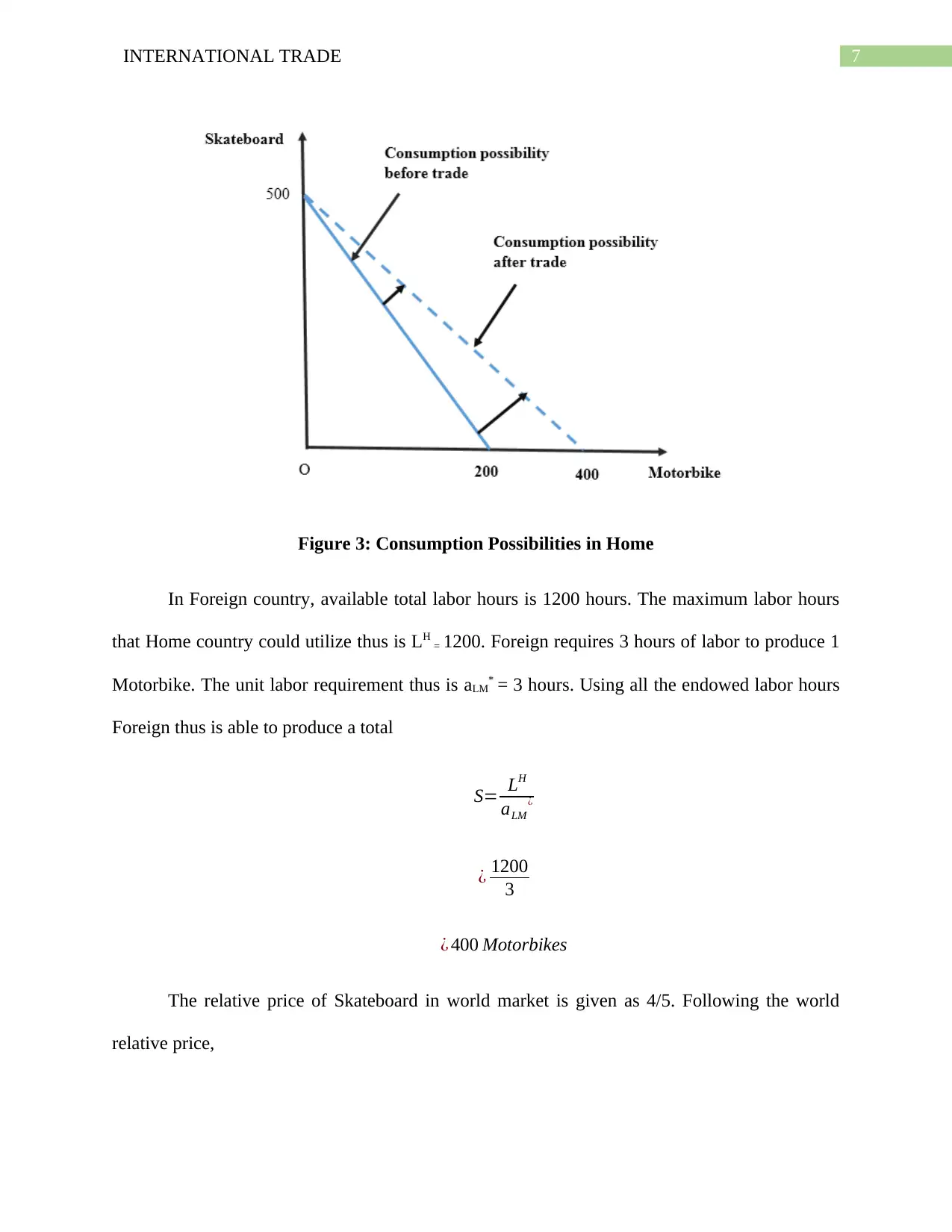
7INTERNATIONAL TRADE
Figure 3: Consumption Possibilities in Home
In Foreign country, available total labor hours is 1200 hours. The maximum labor hours
that Home country could utilize thus is LH = 1200. Foreign requires 3 hours of labor to produce 1
Motorbike. The unit labor requirement thus is aLM* = 3 hours. Using all the endowed labor hours
Foreign thus is able to produce a total
S= LH
aLM
¿
¿ 1200
3
¿ 400 Motorbikes
The relative price of Skateboard in world market is given as 4/5. Following the world
relative price,
Figure 3: Consumption Possibilities in Home
In Foreign country, available total labor hours is 1200 hours. The maximum labor hours
that Home country could utilize thus is LH = 1200. Foreign requires 3 hours of labor to produce 1
Motorbike. The unit labor requirement thus is aLM* = 3 hours. Using all the endowed labor hours
Foreign thus is able to produce a total
S= LH
aLM
¿
¿ 1200
3
¿ 400 Motorbikes
The relative price of Skateboard in world market is given as 4/5. Following the world
relative price,
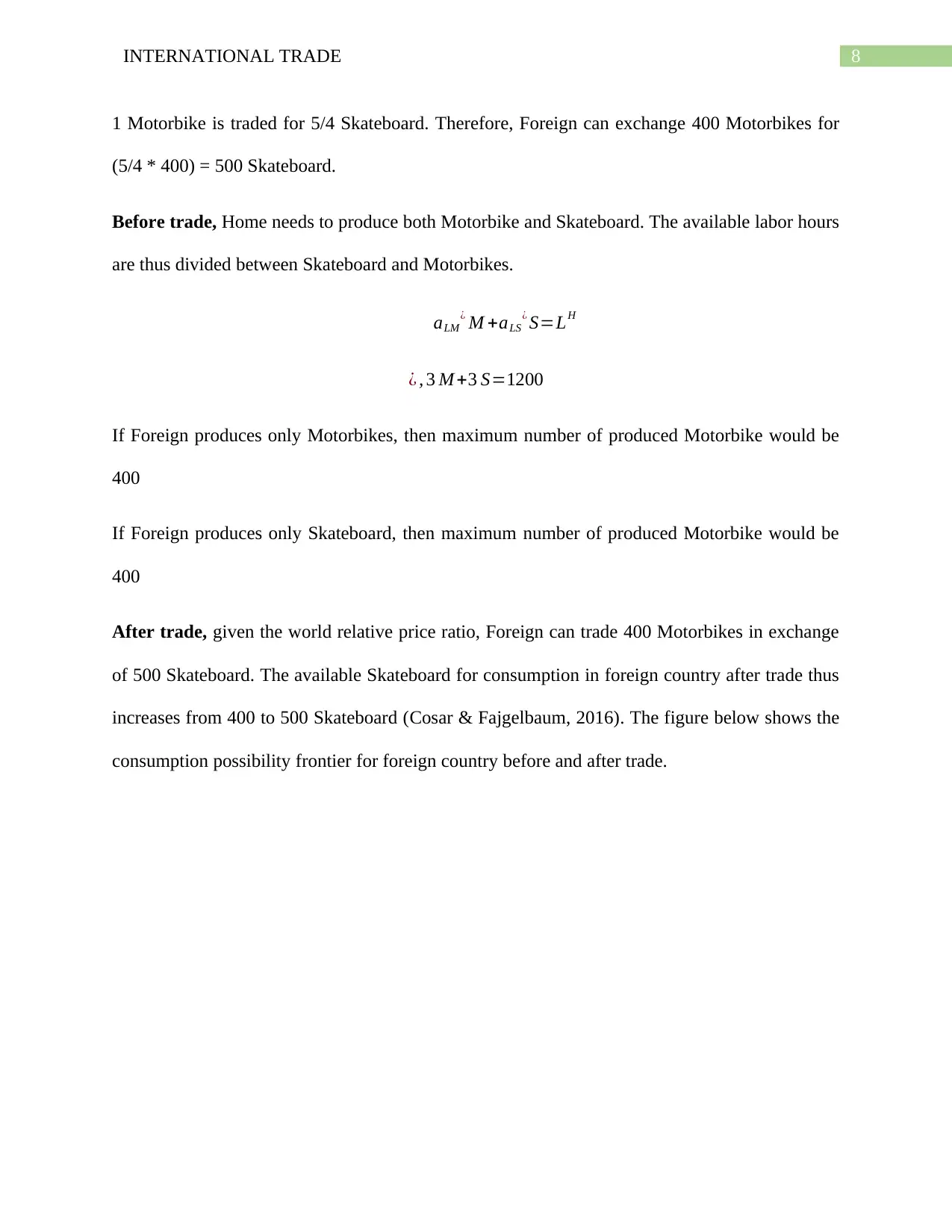
8INTERNATIONAL TRADE
1 Motorbike is traded for 5/4 Skateboard. Therefore, Foreign can exchange 400 Motorbikes for
(5/4 * 400) = 500 Skateboard.
Before trade, Home needs to produce both Motorbike and Skateboard. The available labor hours
are thus divided between Skateboard and Motorbikes.
aLM
¿ M +aLS
¿ S=LH
¿ , 3 M +3 S=1200
If Foreign produces only Motorbikes, then maximum number of produced Motorbike would be
400
If Foreign produces only Skateboard, then maximum number of produced Motorbike would be
400
After trade, given the world relative price ratio, Foreign can trade 400 Motorbikes in exchange
of 500 Skateboard. The available Skateboard for consumption in foreign country after trade thus
increases from 400 to 500 Skateboard (Cosar & Fajgelbaum, 2016). The figure below shows the
consumption possibility frontier for foreign country before and after trade.
1 Motorbike is traded for 5/4 Skateboard. Therefore, Foreign can exchange 400 Motorbikes for
(5/4 * 400) = 500 Skateboard.
Before trade, Home needs to produce both Motorbike and Skateboard. The available labor hours
are thus divided between Skateboard and Motorbikes.
aLM
¿ M +aLS
¿ S=LH
¿ , 3 M +3 S=1200
If Foreign produces only Motorbikes, then maximum number of produced Motorbike would be
400
If Foreign produces only Skateboard, then maximum number of produced Motorbike would be
400
After trade, given the world relative price ratio, Foreign can trade 400 Motorbikes in exchange
of 500 Skateboard. The available Skateboard for consumption in foreign country after trade thus
increases from 400 to 500 Skateboard (Cosar & Fajgelbaum, 2016). The figure below shows the
consumption possibility frontier for foreign country before and after trade.
⊘ This is a preview!⊘
Do you want full access?
Subscribe today to unlock all pages.

Trusted by 1+ million students worldwide
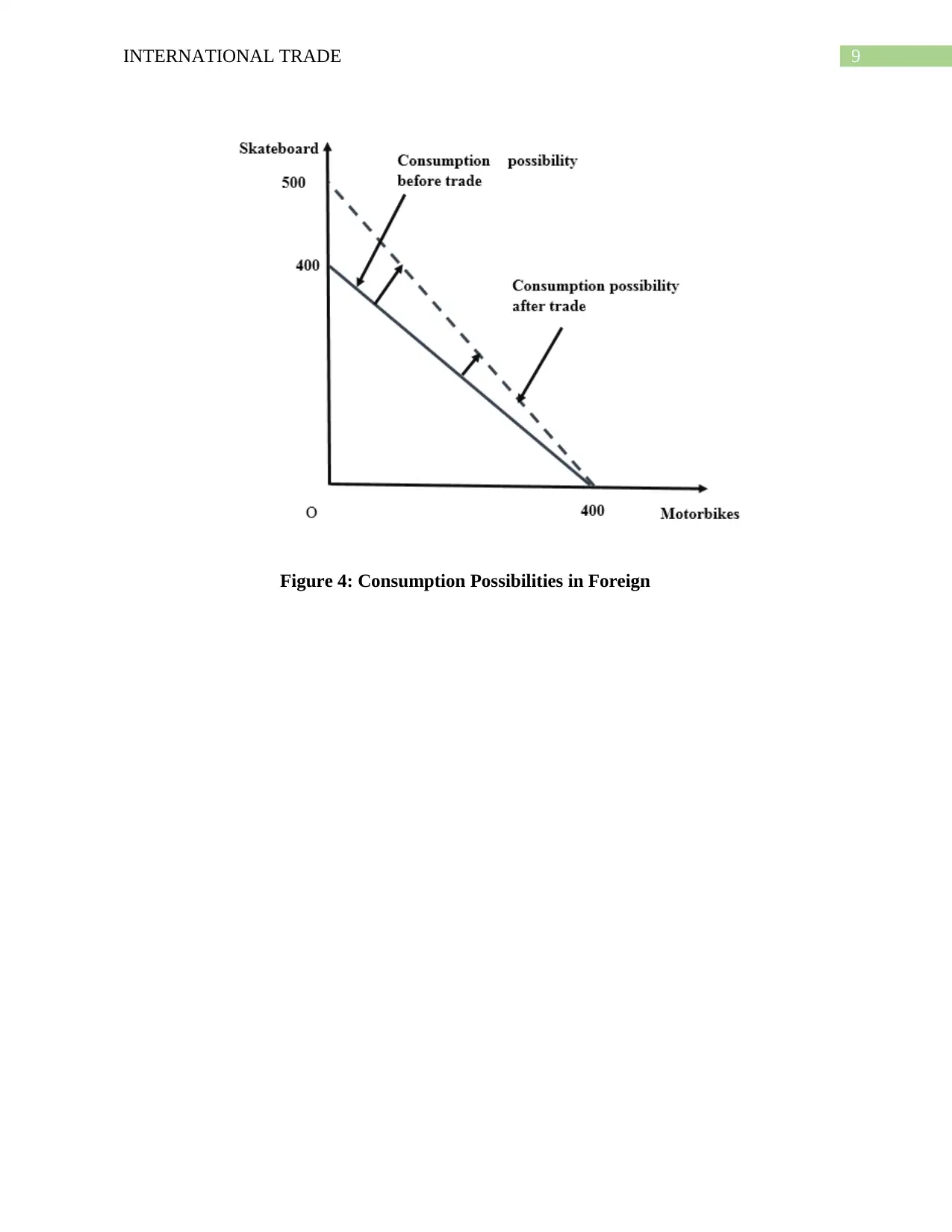
9INTERNATIONAL TRADE
Figure 4: Consumption Possibilities in Foreign
Figure 4: Consumption Possibilities in Foreign
Paraphrase This Document
Need a fresh take? Get an instant paraphrase of this document with our AI Paraphraser
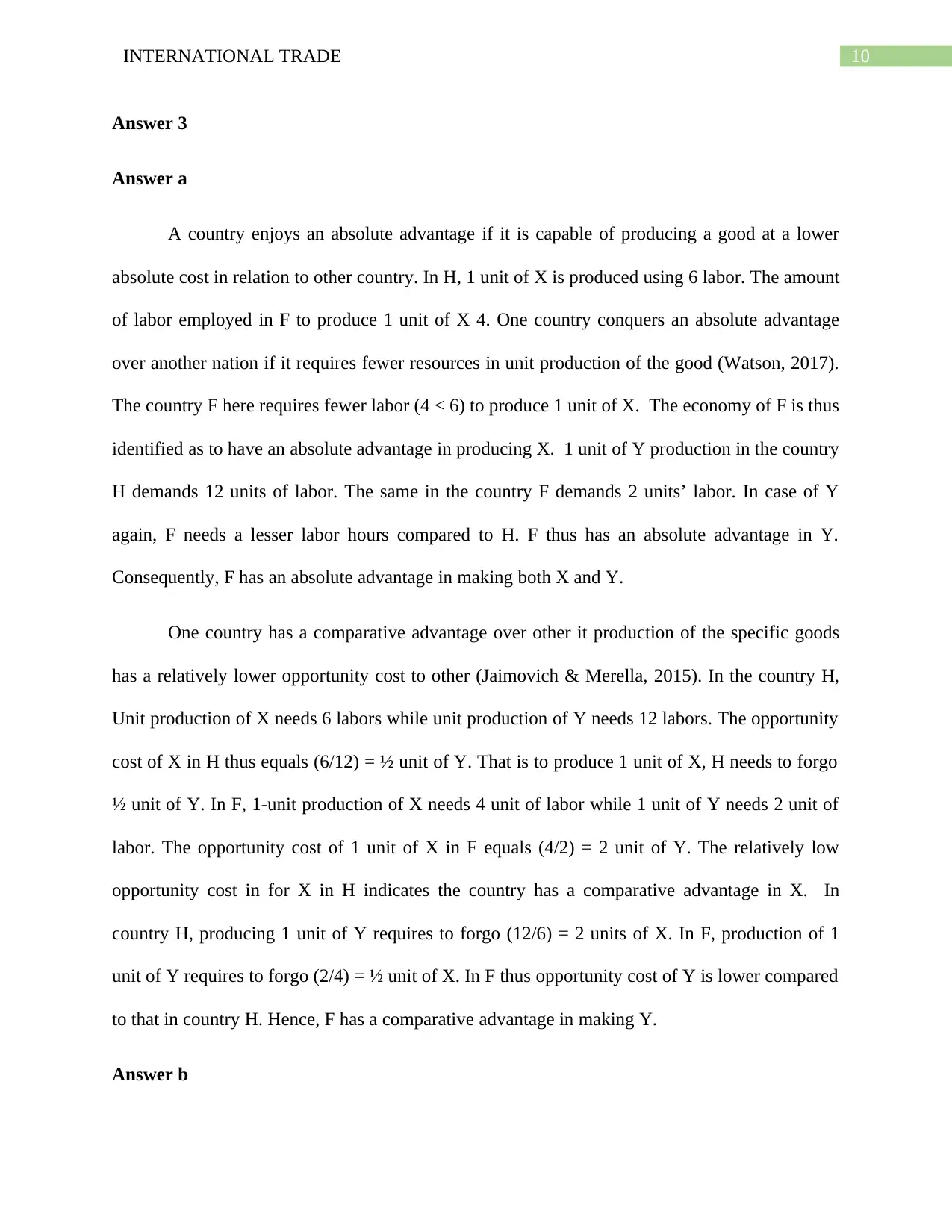
10INTERNATIONAL TRADE
Answer 3
Answer a
A country enjoys an absolute advantage if it is capable of producing a good at a lower
absolute cost in relation to other country. In H, 1 unit of X is produced using 6 labor. The amount
of labor employed in F to produce 1 unit of X 4. One country conquers an absolute advantage
over another nation if it requires fewer resources in unit production of the good (Watson, 2017).
The country F here requires fewer labor (4 < 6) to produce 1 unit of X. The economy of F is thus
identified as to have an absolute advantage in producing X. 1 unit of Y production in the country
H demands 12 units of labor. The same in the country F demands 2 units’ labor. In case of Y
again, F needs a lesser labor hours compared to H. F thus has an absolute advantage in Y.
Consequently, F has an absolute advantage in making both X and Y.
One country has a comparative advantage over other it production of the specific goods
has a relatively lower opportunity cost to other (Jaimovich & Merella, 2015). In the country H,
Unit production of X needs 6 labors while unit production of Y needs 12 labors. The opportunity
cost of X in H thus equals (6/12) = ½ unit of Y. That is to produce 1 unit of X, H needs to forgo
½ unit of Y. In F, 1-unit production of X needs 4 unit of labor while 1 unit of Y needs 2 unit of
labor. The opportunity cost of 1 unit of X in F equals (4/2) = 2 unit of Y. The relatively low
opportunity cost in for X in H indicates the country has a comparative advantage in X. In
country H, producing 1 unit of Y requires to forgo (12/6) = 2 units of X. In F, production of 1
unit of Y requires to forgo (2/4) = ½ unit of X. In F thus opportunity cost of Y is lower compared
to that in country H. Hence, F has a comparative advantage in making Y.
Answer b
Answer 3
Answer a
A country enjoys an absolute advantage if it is capable of producing a good at a lower
absolute cost in relation to other country. In H, 1 unit of X is produced using 6 labor. The amount
of labor employed in F to produce 1 unit of X 4. One country conquers an absolute advantage
over another nation if it requires fewer resources in unit production of the good (Watson, 2017).
The country F here requires fewer labor (4 < 6) to produce 1 unit of X. The economy of F is thus
identified as to have an absolute advantage in producing X. 1 unit of Y production in the country
H demands 12 units of labor. The same in the country F demands 2 units’ labor. In case of Y
again, F needs a lesser labor hours compared to H. F thus has an absolute advantage in Y.
Consequently, F has an absolute advantage in making both X and Y.
One country has a comparative advantage over other it production of the specific goods
has a relatively lower opportunity cost to other (Jaimovich & Merella, 2015). In the country H,
Unit production of X needs 6 labors while unit production of Y needs 12 labors. The opportunity
cost of X in H thus equals (6/12) = ½ unit of Y. That is to produce 1 unit of X, H needs to forgo
½ unit of Y. In F, 1-unit production of X needs 4 unit of labor while 1 unit of Y needs 2 unit of
labor. The opportunity cost of 1 unit of X in F equals (4/2) = 2 unit of Y. The relatively low
opportunity cost in for X in H indicates the country has a comparative advantage in X. In
country H, producing 1 unit of Y requires to forgo (12/6) = 2 units of X. In F, production of 1
unit of Y requires to forgo (2/4) = ½ unit of X. In F thus opportunity cost of Y is lower compared
to that in country H. Hence, F has a comparative advantage in making Y.
Answer b
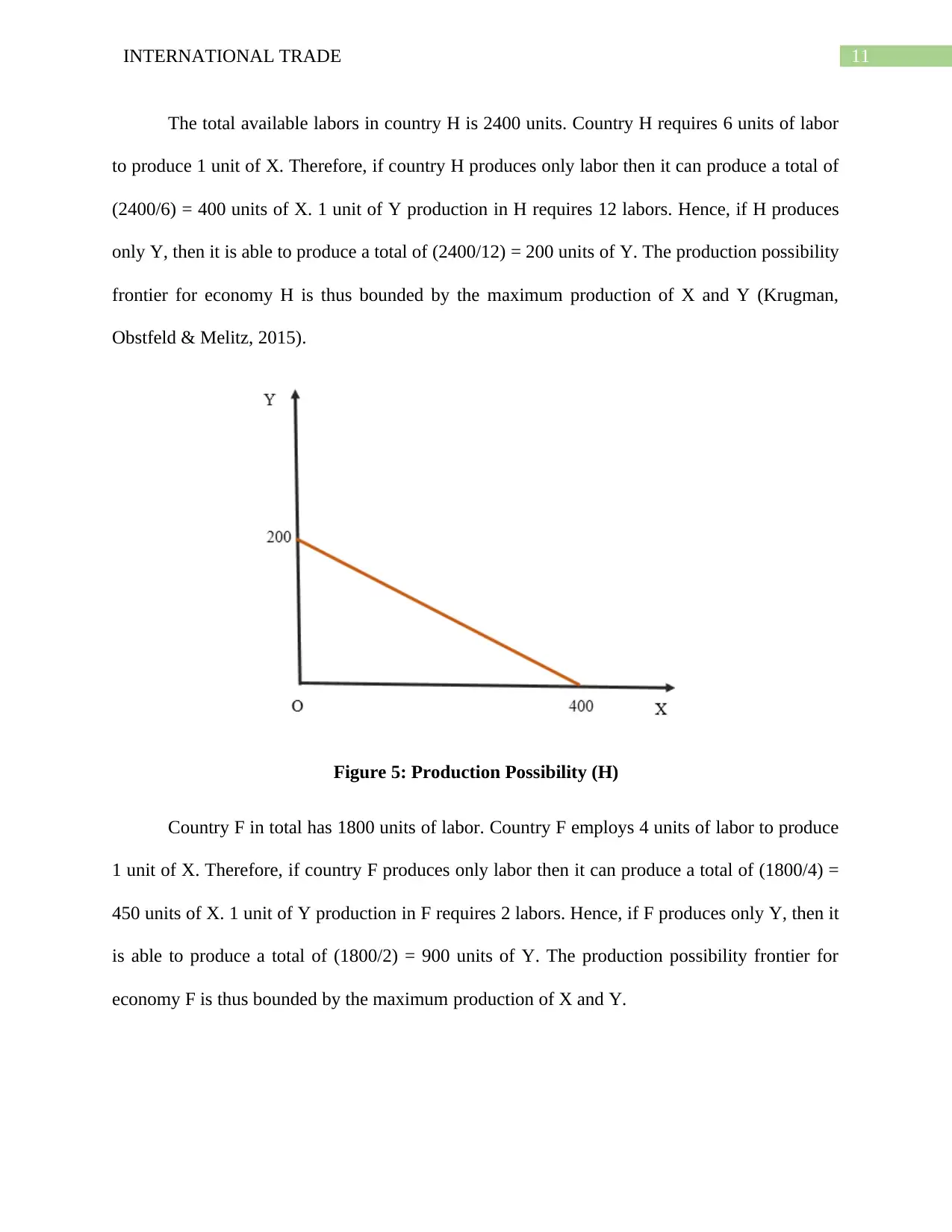
11INTERNATIONAL TRADE
The total available labors in country H is 2400 units. Country H requires 6 units of labor
to produce 1 unit of X. Therefore, if country H produces only labor then it can produce a total of
(2400/6) = 400 units of X. 1 unit of Y production in H requires 12 labors. Hence, if H produces
only Y, then it is able to produce a total of (2400/12) = 200 units of Y. The production possibility
frontier for economy H is thus bounded by the maximum production of X and Y (Krugman,
Obstfeld & Melitz, 2015).
Figure 5: Production Possibility (H)
Country F in total has 1800 units of labor. Country F employs 4 units of labor to produce
1 unit of X. Therefore, if country F produces only labor then it can produce a total of (1800/4) =
450 units of X. 1 unit of Y production in F requires 2 labors. Hence, if F produces only Y, then it
is able to produce a total of (1800/2) = 900 units of Y. The production possibility frontier for
economy F is thus bounded by the maximum production of X and Y.
The total available labors in country H is 2400 units. Country H requires 6 units of labor
to produce 1 unit of X. Therefore, if country H produces only labor then it can produce a total of
(2400/6) = 400 units of X. 1 unit of Y production in H requires 12 labors. Hence, if H produces
only Y, then it is able to produce a total of (2400/12) = 200 units of Y. The production possibility
frontier for economy H is thus bounded by the maximum production of X and Y (Krugman,
Obstfeld & Melitz, 2015).
Figure 5: Production Possibility (H)
Country F in total has 1800 units of labor. Country F employs 4 units of labor to produce
1 unit of X. Therefore, if country F produces only labor then it can produce a total of (1800/4) =
450 units of X. 1 unit of Y production in F requires 2 labors. Hence, if F produces only Y, then it
is able to produce a total of (1800/2) = 900 units of Y. The production possibility frontier for
economy F is thus bounded by the maximum production of X and Y.
⊘ This is a preview!⊘
Do you want full access?
Subscribe today to unlock all pages.

Trusted by 1+ million students worldwide
1 out of 17
Related Documents
Your All-in-One AI-Powered Toolkit for Academic Success.
+13062052269
info@desklib.com
Available 24*7 on WhatsApp / Email
![[object Object]](/_next/static/media/star-bottom.7253800d.svg)
Unlock your academic potential
Copyright © 2020–2025 A2Z Services. All Rights Reserved. Developed and managed by ZUCOL.





